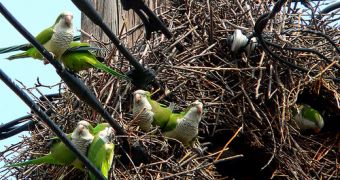The emergence of the human settlements during the Neolithic, 10,000 years ago, created a new biotope. In the new environment, not only domestic animals started to flourish, but also wild fauna that began to depend on human villages - and later cities - for shelter, food, and even security. And not all are useful. For example, house mice and rats rely on food provided by people, from food stores to wastes.
Perhaps the largest number of urban species is represented by birds, not poultry or pets, but wild ones. These birds can even change their traditional behavior.
Amongst the oldest "urban citizens" are the turtledoves, rock pigeons, collared doves, sparrows, crows, ravens, jackdaws, tits, thrushes, swallows. In urban areas with vegetation, starlings and blackbirds may abound, and close to waters (or not), city gulls.
Some birds, whether living in the cities or outside them, are well adapted to the urban environment. These are urbanophile species, like the blackbird, European starling, hooded crow and partially the raven. The interesting fact is that these species established in the cities lost the migration impulse, isolated from their non-urbanized peers, remained migratory.
Other birds have not adapted yet to the proper city, unable to cope with its conditions, but nest at the boundaries of the cities, in transitional areas where nature is still alive, not invaded by urbanization (buildings, streets and excessive traffic). Some birds are in an intermediary situation: the barn swallow is clearly an urbanophile species but in the large cities, it prefers the periphery, for a sole reason: too much concrete and asphalt make it difficult to find the raw material for building the nests.
Nowadays, the cities may make a safer place for birds, because the agricultural fields, despite the abundance of food, are filled with toxic fertilizers and pesticides.
In fact, the number of wild species conquering the cities is increasing. Imagine that 100 years ago the collared dove was unknown in Europe, and now, besides being one of the most common birds of the European cities, are found in Europe strictly inside cities and villages.
Perhaps the main barrier the birds have to overcome is the psychological one: they must lose the fear of human presence. The crows are amongst the species that bypassed this barrier easily. In wild areas, crows are discrete birds, nesting in hidden places, as a protection against the prey birds. Oppositely, this bird proves to be very courageous in the big cities, nesting without any shyness in the trees placed in intersections, agglomerated parks and in front of railway stations. In these places, the birds are attracted by the abundance of food and the higher security of the place, despite the intense car and pedestrian traffic. The adaptation of the birds to the city life has required a "pragmatic intelligence".

 14 DAY TRIAL //
14 DAY TRIAL //